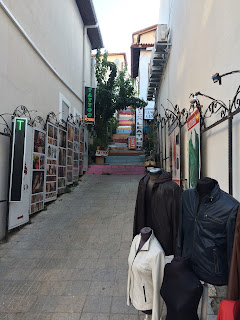A slightly later start to the day had us on the tram to Çembelitas for a walk through the Bazaars. We started at the Çemberlitas Column, erected by order of Emperor Constantine to celebrate Constantinople's dedication as the capital of the Roman Empire in 330.
As we headed down to the Grand Bazaar, a gentleman pointed out a short cut to the Bazaar and explained to us that when he was a child, Çembelitas was a place for families, however it had now become an area of commerce. As luck would have it, his family were carpet merchants! He invited us to view his carpets, which we politely declined, however asked about the Hammami, and he took us back up the street to its entrance. His friend (and masseuse) was just turning up for work, so when we told him we would be back later, he gave us the name of the masseuse and we agreed that 3pm would be a good time for a Turkish Bath.
We headed down into the Grand Bazaar - one of the largest and oldest covered markets in the world. Reputed to have between 3,000 and 4,000 shops, our friend from earlier in the day told us that due to the downturn in tourism about 1,000 of these had closed. It was certainly very quiet with the traders trying to gain our attention.
After purchasing some Turkish Delight, we wandered, eventually succumbing to a shop selling hand embroidered table cloths, runners etc. The young man invited us in and so started the theatre that surrounded our purchase! Firstly, we needed to indicate what size we wanted - table runner - and then we were shown every design that was in the shop in that size. We were offered, and accepted, tea which was brought from a neighbouring stall by a young boy. During this process, the second chap kept Michael occupied and chatting (not sure who was the chattiest!) Next we narrowed our choices down to about half a dozen. At this stage, we started to talk price and eventually agreed though not before the young man advised that if he could marry Caitlin then we could have the whole shop!
We continued to wander around the bazaar, eventually exiting and working our way down to the Spice Market - sometimes known as the Egyptian Market because it is said to have been built with the proceeds from the eyalet (administrative area) of Egypt in the 1660s. Initially the centre of the spice trade in Istanbul, it now houses shops of all kinds and is said to be the main market for the locals. When visiting in 2005, I had preferred this market to the Grand Bazaar, however this visit, I felt it had become run down and the traders a lot more aggressive. Many of the displays had signs indicating that they would not 'haggle' but the price indicated was the 'best' price.
Despite this, the traders tried to use some clever lines - 'please enter, the only thing I don't have in my shop is customers'...... 'can I sell you something that you don't need?'...... etc. Again we wandered through the area, finally exiting near the tram stop on the Bosphorus. From here we took a ride out into the suburban areas and back into the old city where we left our purchases and headed off for our Turkish Bath.
The Çemberlitas Hamami was established by the wife of Sultan Selim II, Nurbanu, in about 1584, to bring in revenue to support the Valide-i-Atik Charity Complex in Toptasi, Üsküder. Planned and built as a double bath, it still has separate women's and men's sections. Though there have been many changes over the years, the women's section still has the original lantern - a dome-shaped cupola resting on decorated arches and columns. We felt our sightseeing from the last couple of days had earned us the bath and massage which we really enjoyed. Again, I was struck by how quiet it was ... during my visits in 2005, I sometimes had to wait for a space on the hot stone. This time, Caitlin and I joined two other women as the sole users of the facility.
Our dinner choice tonight was a small stall where they served kebabs of lamb, skewered from the main rotating meat piece and then thinly sliced off. Served with freshly made flat bread and salad, we voted it one of our best meals. We then visited the local Haci Bekir store - part of the chain of shops around Istanbul, originating in 1777 and winning the sultan's seal of approval! Over some very rich cakes and puddings, we solved the world's problems and watched as a parade of local Turks also enjoyed the many treats on offer.
Valide-i Atik Charity Complex in






















































